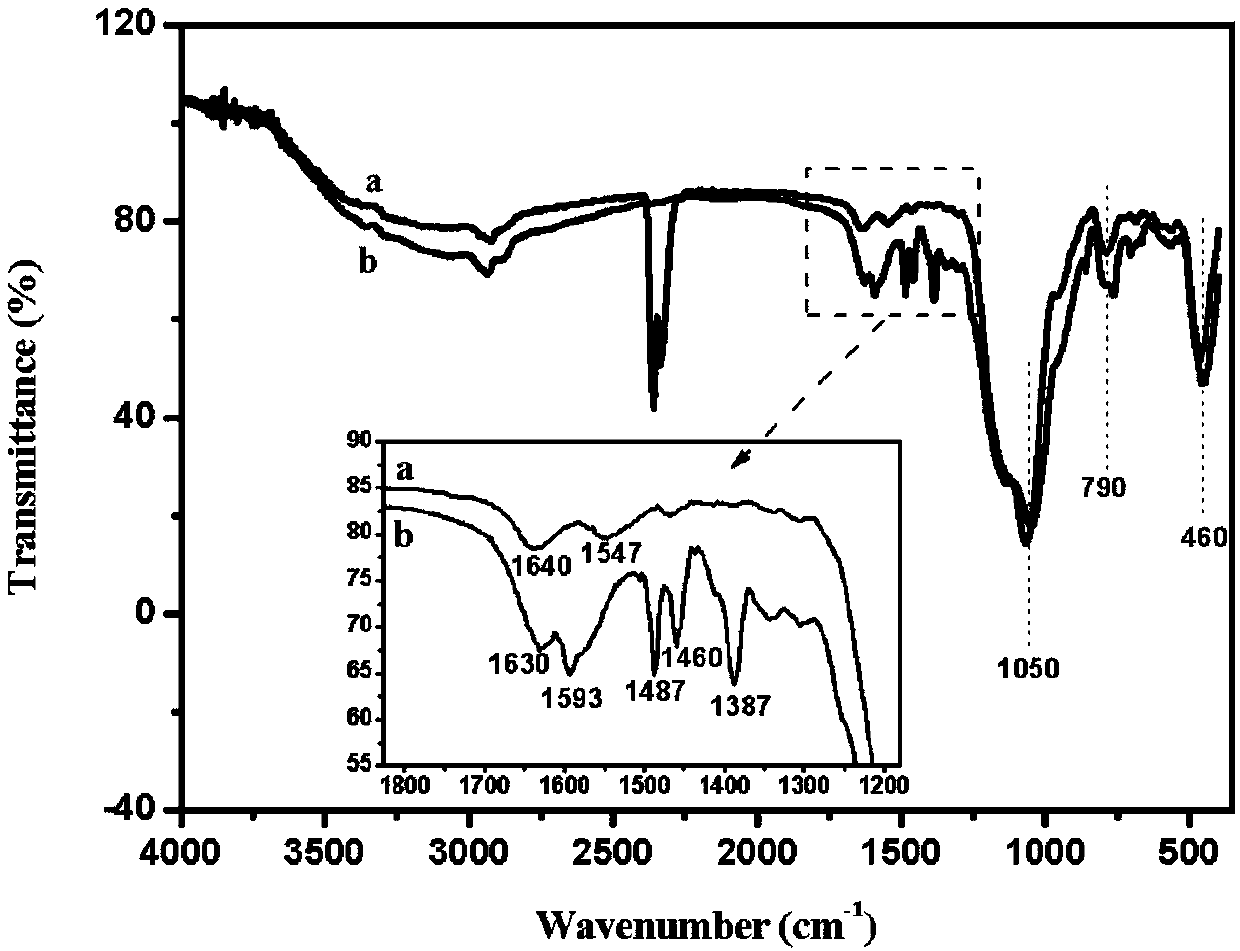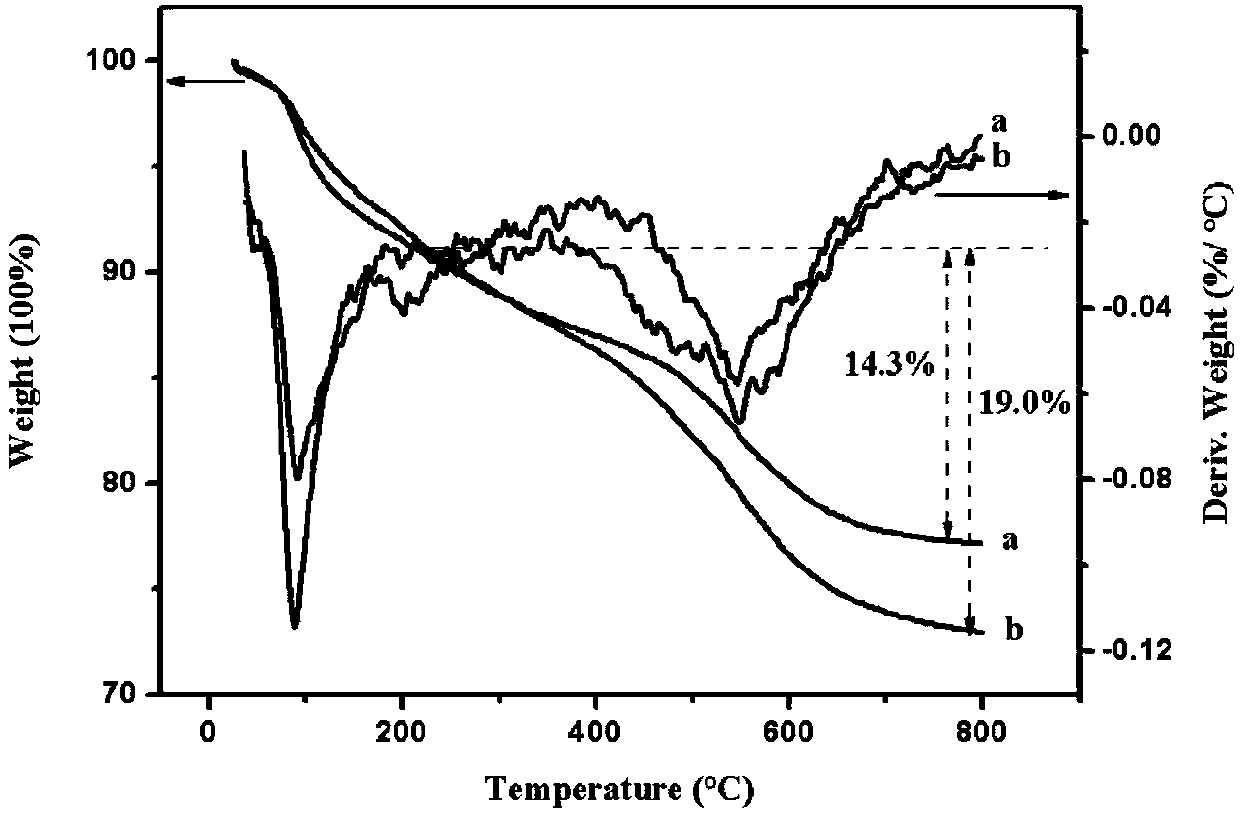Salicylic acid-doped silica nano-particle fluorescence sensor for iron ions, and production method and application thereof
A fluorescent sensor and silicon dioxide technology, applied in fluorescence/phosphorescence, material excitation analysis, etc., can solve the problems of expensive equipment, poor selectivity, and complicated operation, and achieve the effect of simple steps, mild method conditions, and easy steps
- Summary
- Abstract
- Description
- Claims
- Application Information
AI Technical Summary
Problems solved by technology
Method used
Image
Examples
Embodiment 1
[0036] In this example, salicylic acid-doped silica nanoparticles Fe 3+ The preparation method of fluorescent sensor is carried out according to the following steps:
[0037] (1) Add 100 mg of salicylic acid (SA) and 35 mL of absolute ethanol into a 50 mL round bottom flask, and stir for 20 min at room temperature under a nitrogen atmosphere;
[0038] (2) Then continue to add 310 μL of 3-aminopropyltriethoxysilane (APTES) and 1.4 mL of tetraethylorthosilicate (TEOS), and continue to stir for 30 minutes;
[0039] (3) Then add 120 μL of 25% NH 3 ·H 2 A mixed solution of O and 860 μL of water was passed through nitrogen for 30 minutes to remove oxygen, then the flask was sealed and stirred overnight for 24 hours;
[0040] (4) The product was collected by centrifugation, washed 5 times with 5 mL of absolute ethanol, and finally vacuum-dried at 50° C. for 12 h. The obtained white powder was salicylic acid-doped silica nanoparticles (SASP).
Embodiment 2
[0042]In this example, salicylic acid-doped silica nanoparticles Fe 3+ The preparation method of fluorescent sensor is carried out according to the following steps:
[0043] (1) Add 50 mg of salicylic acid (SA) and 35 mL of absolute ethanol into a 50 mL round bottom flask, and stir for 15 min at room temperature under a nitrogen atmosphere;
[0044] (2) Then continue to add 310 μL of 3-aminopropyltriethoxysilane (APTES) and 775 μL of tetraethylorthosilicate (TEOS), and continue to stir for 20 minutes;
[0045] (3) Then add 80 μL of 25% NH 3 ·H 2 O and 860 μL water mixed solution, through nitrogen gas for 45min to remove oxygen, then seal the flask and stir for 12h;
[0046] (4) The product was collected by centrifugation, washed 5 times with 5 mL of absolute ethanol, and finally dried in vacuum at 30° C. for 15 h, and the obtained white powder was salicylic acid-doped silica nanoparticles (SASP).
Embodiment 3
[0048] In this example, salicylic acid-doped silica nanoparticles Fe 3+ The preparation method of fluorescent sensor is carried out according to the following steps:
[0049] (1) Add 120mg of salicylic acid (SA) and 35mL of absolute ethanol into a 50mL round bottom flask, and stir for 45min at room temperature under a nitrogen atmosphere;
[0050] (2) Then continue to add 310 μL of 3-aminopropyltriethoxysilane (APTES) and 1.7 mL of tetraethylorthosilicate (TEOS), and continue to stir for 60 minutes;
[0051] (3) Then add 150 μL of 25% NH 3 ·H 2 O and 860 μL of water mixed solution, through nitrogen for 60min to remove oxygen, then seal the flask and stir for 30h;
[0052] (4) The product was collected by centrifugation, washed 5 times with 5 mL of absolute ethanol, and finally vacuum-dried at 55° C. for 8 h, and the obtained white powder was salicylic acid-doped silica nanoparticles (SASP).
PUM
| Property | Measurement | Unit |
|---|---|---|
| Size | aaaaa | aaaaa |
Abstract
Description
Claims
Application Information
 Login to View More
Login to View More - R&D
- Intellectual Property
- Life Sciences
- Materials
- Tech Scout
- Unparalleled Data Quality
- Higher Quality Content
- 60% Fewer Hallucinations
Browse by: Latest US Patents, China's latest patents, Technical Efficacy Thesaurus, Application Domain, Technology Topic, Popular Technical Reports.
© 2025 PatSnap. All rights reserved.Legal|Privacy policy|Modern Slavery Act Transparency Statement|Sitemap|About US| Contact US: help@patsnap.com



